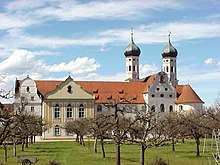Carmina Burana
They were written by students and clergy when Latin was the lingua franca throughout Italy and western Europe for travelling scholars, universities, and theologians.
The manuscripts reflect an international European movement, with songs originating from Occitania, France, England, Scotland, Aragon, Castile and the Holy Roman Empire.
Carmina Burana (CB) is a manuscript written in 1230 by two different scribes in an early gothic minuscule[3] on 119 sheets of parchment.
[4] At some point in the Late Middle Ages, the handwritten pages were bound into a small folder called the Codex Buranus.
[9] In support of Kloster Neustift, the text's open-mindedness is characteristic of the reform-minded Augustine Canons Regular of the time, as is the spoken quality of the writing.
[13] Fritz Peter Knapp suggested that the manuscript could have traveled in 1350 by way of the Wittelsbacher family who were Vögte of both Tirol and Bavaria, if it was written in Neustift.
In this parody world, the rules of priesthood include sleeping in, eating heavy food and drinking rich wine, and regularly playing dice games.
These rules were described in such detail that older research on the Carmina Burana took these descriptions literally and assumed there actually existed such a lazy order of priests.
[20] The text is mostly an anonymous work, and it appears to have been written by Goliards and vagrants who were either theology students travelling between universities or clerics who had not yet received a prebendary.
Presumably these individuals scrounged and begged for a living, which might explain why a good portion of the moral songs are dedicated to condemning those who are not generous alms givers (e.g., CB 3, 9, 11, and 19–21).
The authors demonstrate a broad knowledge of ancient mythology, which they employ to rich effect through metonymy and allegorical references, and which they effortlessly weave into scenes from the Bible.
[21][22] Aretin regarded the Codex as his personal reading material, and wrote to a friend that he was glad to have discovered "a collection of poetic and prosaic satire, directed mostly against the papal seat".
[26] Publisher Johann Andreas Schmeller chose a misleading title for the collection, which created the misconception that the works contained in the Codex Buranas were not from Benediktbeuern.
[28] The two based their edition on previous work by Munich philologist Wilhelm Meyer, who discovered that some pages of the Codex Buranus had mistakenly been bound into other old books.



